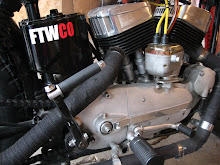This test for rod straightness always seems rather mundane.
If your motor was running ok, why check it?
Here's why:
Especially, if you are building an engine from a variety of parts - this is a very important step in the process. S&S Cycle and Jims both offer a long "precision pin" which you can insert in your bushing, and run down to the cylinder base. You can use a feeler gauge (I use a thin piece of carbon-type paper) and determine if your connecting rods are slightly bent. The pin should hold your paper between the pin and the base on each side - you should feel a drag on the paper . . . On my engine, the front rod was perfect. The rear rod was off (+.016) which is quite a bit ! I bolted my lower in the stand, C-clamped it to the bench, and using the special tool the boys made years ago . . . proceeded to bend my rod back for straightness. Do a little at a time. First, I got to +.006, then +.004, then .000 (perfect). However, the rod may "relax" a bit back to a positive reading . . . so you may want to go beyond (-.001 or so . . ) and it will relax back to a zero reading. It sounds crazy - but, this is the way you do it. S&S has full instructions how to make a tool. Now you have the best chance for less drag, better ring seating, better compression, increased power and longer engine life.



















2 comments:
Unreal Noot, thanks for the lesson, love the solid gudgeon pin thingy.
That's the part of the process I hate!! How do you feel about the tools that bend the rod from the wrist pin location?
Post a Comment